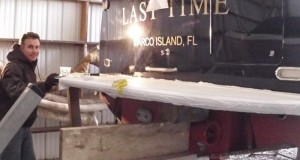Still very nippy today even though we are expecting a balmy 40 degrees sometime this afternoon but snow later in the week.
Kevin and Rumsey are installing a swim platform on a very nice MJM34 out in one of our buildings. This was dry fit a few weeks ago but Kevin needed a hand getting it installed and everyone was tied up with winterizing and boat hauling. This boat is a gem and is for sale. For more information call John at 410-822-8556.

Not much else to report today – the mechanics are in Oxford working on a boat that is under contract. We should be starting more repair jobs later this week after this boat is wrapped up. I decided that this would be a good educational day. From one of my emails from a well known boating site I received the latest USCG Required gear list and it is worth sharing for safety (and legal) reasons.
United States Coast Guard Required Items on All Vessels
- NUMBERING: Must be properly and permanently affixed in format according to state regulations in block letters no less than 3 inches high and in a color contrasting with the background. A space or hyphen must separate the letters from the numbers and from the letters to the state decal (CT 1234 AA 07 or CT-1234-AA 07).
- REGISTRATION / DOCUMENTATION: Registration and Documentation (if applicable) must be onboard and available. If documented, numbers must be permanently marked on a visible part of the interior structure. The documented boat’s name and hailing port must be displayed on the exterior hull in letters not less than 4 inches in height and contrasting with the background.
- PERSONAL FLOTATION DEVICES (PFD’s / LIFEJACKETS): Acceptable PFD’s must be U. S. Coast Guard approved and in good serviceable condition. A wearable PFD of suitable size is required for each person on the boat. Children must have properly sized PFD’s designed for children. Wearable PFD’s must be ”readily accessible.” Boats 16 feet or longer must also have one (1) Type IV (throwable) device, which shall be “immediately available.” PFD’s shall not be stored in unopened plastic packaging. For Personal Watercraft (PWC) riders, the PFD must be worn. An impact rating is suggested but not required.
- VISUAL DISTRESS SIGNALS: Recreational boats, 16 feet and over, used on coastal waters or the Great Lakes are required to carry a minimum of either 1) three day and three night pyrotechnic devices, 2) one day non-pyrotechnic device (flag) and one night non-pyrotechnic device (SOS light) or, 3) a combination of 1 and 2.
- FIRE EXTINGUISHERS: Fire extinguishers are required if one of the following conditions exists: 1) Inboard engine(s); 2) Double bottom hulls not completely sealed or not completely filled with flotation materials; 3) Closed living space; 4) Closed stowage compartments that contain flammable materials; or 5) Permanently installed fuel tanks.Recreational boats less than 26 feet and propelled by outboard motors are NOT required to have fire extinguishers unless one or more of conditions 2-5 listed above exist. Fire extinguishers must be “readily accessible and verified as serviceable.” Minimum requirements:

- VENTILATION: Boats with gasoline engines with closed compartments, built after 01 August 1980 must have a powered ventilation system. Those built prior to that date must have natural or powered ventilation. Boats with closed fuel tank compartments built after 01 August 1978 must meet requirements by displaying a “certificate of compliance.” Boats built before that date must have either natural or powered ventilation in the fuel tank compartment.
- BACKFIRE FLAME ARRESTER: All gasoline powered inboard/outboard or inboard motorboats must be equipped with an approved backfire flame control device.
- SOUND PRODUCING DEVICES: To comply with Navigation Rules and for distress signaling purposes, ALL boats must carry a sound producing device (whistle, horn, siren, etc.) capable of a four (4) second blast that is audible for ½ mile. All boats 65’(20 m) or greater must have a bell that complies with Navigation Rules. (Check state laws: for example, Boats 26’ or greater, examined in Connecticut, are required to have a bell.)
- NAVIGATION LIGHTS: All boats must be able to display navigation lights between sunset and sunrise and in conditions of reduced visibility. Boats 16’ or over in length must have properly installed, working navigation lights and an all-around anchor light capable of being lit independently from the red/green/white “running” lights.
- POLLUTION PLACARD: Boats 26’ and over in length with a machinery compartment must display an oil waste “pollution” placard.
- MARPOL TRASH PLACARD: Boats 26’ and over in length, operating in U.S. navigable waters, MUST display a “MARPOL” trash placard. Oceangoing boats (capable of being on the ocean) 40’ and over must also have a written trash disposal plan.
- MARINE SANITATION DEVICES: Any installed toilet must be a Coast Guard approved device. Overboard discharge outlets must be capable of being sealed. (Check for your state or local requirements, for example, all discharge outlets must be sealed in Long Island Sound.)
- NAVIGATION RULES: Boats 39’4” or over must have a current copy of the Navigation Rules. Buy A Copy From Amazon

- STATE and LOCAL REQUIREMENTS: These requirements must be met before the “Vessel Safety Check” decal can be awarded. A boat must meet the requirements of the state in which it is being examined.
- OVERALL BOAT CONDITION: As it applies to the vessel. Including, but not limited to:
- Deck free of hazards and Clean Bilge: The boat must by free of fire hazards, in good overall condition, with bilges reasonably clean and visible hull structure generally sound. The use of automobile parts is NOT ACCEPTABLE. Engine horsepower must not exceed that shown on the capacity plate.
- Electrical and Fuel System: The electrical system must be protected by either fuses or manual reset circuit breakers. Switches and fuse panels must be protected from rain or water spray. Wiring must be in good condition, properly installed and with no exposed conductor or deteriorated insulation. Batteries must be secured and terminals covered to prevent accidental arcing. If installed, self-circling or kill switch mechanisms must be in proper working order. All PWC’s require a self-circling or kill switch mechanism.
- Galley and Heating System: System and fuel tanks must be properly secured with no flammable materials nearby.
- Marine Radio (VHF/FM): If it has DSC, get your MMSI and install correctly.
- Dewatering device (bilge pump) and backup. Check your pumps.
- Mounted Fire Extinguishers: You’ll know where they are.
- Anchor & appropriate length and type of Anchor Rode.
- First Aid and PIW kits.
- Inland Visual Distress Signals.
- CO detectors in each cabin
RECOMMENDED ITEMS: While these items are not required for the award of the Vessel Safety Check decal, for the most prudent boaters, we recommend additional items. Meeting these criteria shows your commitment and concern for Boating Safety.
 Not much else to report today – the mechanics are in Oxford working on a boat that is under contract. We should be starting more repair jobs later this week after this boat is wrapped up. I decided that this would be a good educational day. From one of my emails from a well known boating site I received the latest USCG Required gear list and it is worth sharing for safety (and legal) reasons.
United States Coast Guard Required Items on All Vessels
Not much else to report today – the mechanics are in Oxford working on a boat that is under contract. We should be starting more repair jobs later this week after this boat is wrapped up. I decided that this would be a good educational day. From one of my emails from a well known boating site I received the latest USCG Required gear list and it is worth sharing for safety (and legal) reasons.
United States Coast Guard Required Items on All Vessels


